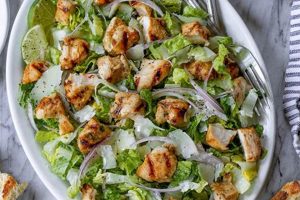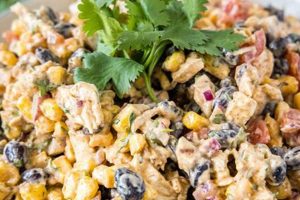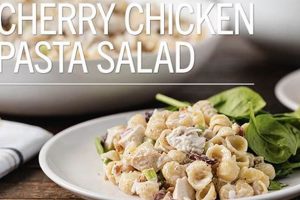Transforming cooked chicken into a new dish offers a practical and delicious way to minimize food waste and create satisfying meals. This culinary approach involves combining shredded or diced chicken with various complementary ingredients, often including mayonnaise, celery, onion, and seasonings. Variations can incorporate fruits, nuts, herbs, and different dressings to create a wide range of flavor profiles.
Resourcefulness in the kitchen has long been valued, and repurposing leftover ingredients is a cornerstone of this tradition. Creating new dishes from cooked chicken not only reduces waste but also provides an opportunity for culinary creativity and cost savings. The versatility of chicken allows for its incorporation into sandwiches, wraps, salads, or enjoyed as a standalone dish. This adaptability makes it a valuable ingredient for both quick weeknight meals and more elaborate preparations.
The following sections will explore a variety of approaches, from classic preparations to more innovative combinations, offering inspiration and guidance for maximizing the potential of cooked chicken.
Tips for Utilizing Cooked Chicken
Maximizing the potential of cooked chicken involves understanding key techniques and flavor combinations. These tips offer guidance for creating delicious and varied dishes.
Tip 1: Proper Chicken Preparation: Ensure the chicken is cooled completely before incorporating it into other dishes. Shredding or dicing the chicken into consistent sizes promotes even distribution and enhances the overall texture.
Tip 2: Balancing Flavors: Consider the existing flavors of the cooked chicken when selecting additional ingredients. For example, roasted chicken with herbs pairs well with complementary flavors, while plain poached chicken offers a blank canvas for bolder seasonings.
Tip 3: Enhancing Texture: Incorporating ingredients with contrasting textures adds complexity. Crisp celery, crunchy nuts, or juicy grapes can provide textural variety.
Tip 4: Dressing Considerations: The choice of dressing significantly influences the final flavor profile. Classic mayonnaise-based dressings offer a creamy richness, while vinaigrette-based options provide a lighter, tangier alternative.
Tip 5: Creative Ingredient Combinations: Explore beyond traditional ingredients. Dried fruits, curry powder, or fresh herbs can elevate a simple chicken salad to a more complex and flavorful dish.
Tip 6: Proper Storage: Store leftover chicken salad in an airtight container in the refrigerator. Consume within three to four days for optimal quality and food safety.
Tip 7: Serving Suggestions: Chicken salad offers versatile serving options. Consider serving it in sandwiches, wraps, lettuce cups, or as a filling for baked potatoes or tomatoes.
By following these guidelines, one can transform cooked chicken into a versatile and delicious component of numerous meals, minimizing waste and maximizing culinary potential.
The following section will provide specific recipe examples showcasing these tips in practice.
1. Flavor Balance
Flavor balance is paramount in crafting successful dishes using leftover cooked chicken. A harmonious blend of tastes elevates a simple combination of ingredients into a cohesive and satisfying culinary experience. Understanding how different flavor profiles interact is crucial for creating compelling chicken salad variations.
- Acidity as a Counterpoint to Richness:
The inherent richness of cooked chicken, especially when combined with mayonnaise or other creamy dressings, benefits from the addition of acidic elements. Ingredients like lemon juice, vinegar, or chopped pickles cut through the richness, providing a refreshing contrast and preventing the final product from feeling heavy. For instance, a chicken salad featuring roasted chicken with a Dijon-mustard based dressing can be balanced with the addition of chopped cornichons or a splash of white wine vinegar.
- Integrating Sweet and Savory Notes:
Incorporating a touch of sweetness can further enhance the complexity of chicken salad. Dried cranberries, chopped grapes, or a drizzle of honey can complement savory elements like herbs, spices, and nuts. The interplay of sweet and savory notes creates a more dynamic and nuanced flavor profile. A curry-infused chicken salad, for example, can benefit from the addition of golden raisins or chopped mango to counterbalance the spices.
- The Role of Aromatic Ingredients:
Fresh herbs, spices, and alliums contribute significantly to the overall flavor balance. These aromatic ingredients add depth and complexity, enhancing the other flavors present in the chicken salad. Fresh dill, tarragon, or chives provide bright, herbaceous notes, while spices like curry powder or smoked paprika introduce warmth and depth. The judicious use of onions, shallots, or garlic adds savory complexity. A classic chicken salad might feature fresh parsley and celery, while a more adventurous version could incorporate cilantro, mint, and ginger.
- Considering the Base Flavor Profile:
The initial flavor profile of the cooked chicken influences ingredient choices. If the chicken was roasted with herbs like rosemary and thyme, those flavors should be considered when selecting additional ingredients. Similarly, simply poached chicken provides a neutral backdrop that allows for a wider range of flavor combinations. Building upon the existing flavor profile of the chicken creates a more cohesive final dish. For example, smoked chicken pairs well with ingredients like chipotle peppers and black beans, while lemon-herb roasted chicken complements ingredients like feta cheese and artichoke hearts.
By carefully considering these facets of flavor balance, one can transform leftover cooked chicken into a wide array of flavorful and satisfying salads. The interplay of acidity, sweetness, aromatics, and the chicken’s base flavor creates a symphony of taste that elevates a simple dish into a culinary delight.
2. Texture Variation
Texture variation plays a crucial role in the overall enjoyment of leftover chicken salad. A dynamic interplay of textures elevates the dish beyond a simple combination of ingredients, creating a more engaging and satisfying sensory experience. This textural diversity adds complexity and interest, preventing the salad from feeling monotonous.
Several strategies can be employed to achieve optimal textural variation. Incorporating crunchy elements, such as chopped celery, water chestnuts, or toasted nuts, provides a stark contrast to the tenderness of the chicken. These contrasting textures create a delightful interplay in each bite. Adding ingredients with varying degrees of firmness, like grapes or dried cranberries, further enhances this complexity. The choice of ingredients should also consider the existing texture of the chicken itself. Shredded chicken offers a different textural experience compared to diced chicken, influencing the choice of complementary ingredients. For instance, a salad with shredded chicken might benefit from the addition of chopped pecans and diced apples, while a salad with diced chicken might pair well with sliced grapes and slivered almonds.
Understanding the interplay of textures allows for a more deliberate and nuanced approach to creating chicken salad. This consideration results in a more enjoyable culinary experience. The strategic inclusion of ingredients with varying textures elevates the dish from simple sustenance to a more complex and satisfying meal. Failing to incorporate textural variety can result in a bland and unappealing dish, highlighting the practical significance of this understanding in recipe development. Ultimately, achieving textural balance demonstrates culinary skill and enhances the overall dining experience.
3. Ingredient Quality
Ingredient quality significantly impacts the overall flavor, texture, and enjoyment of dishes prepared with leftover cooked chicken. Utilizing high-quality ingredients elevates these dishes from simple, economical meals to more refined and satisfying culinary experiences. Subpar ingredients can compromise the final product, resulting in a less appealing and potentially disappointing outcome. Therefore, careful consideration of ingredient quality is crucial for maximizing the potential of leftover chicken.
- Freshness of Produce:
Fresh produce contributes bright, vibrant flavors and crisp textures. Wilted or decaying produce imparts off-flavors and detracts from the overall quality of the dish. For example, using crisp, fresh celery and onion enhances the flavor and texture of a classic chicken salad, while using limp or browning produce compromises the final result. Selecting produce at peak ripeness ensures optimal flavor and contributes to a more appealing final product.
- Quality of Mayonnaise and Other Dressings:
Mayonnaise serves as the foundation for many chicken salad variations. Using high-quality mayonnaise, preferably made with real eggs and minimal additives, contributes a rich, creamy texture and clean flavor. Lower-quality mayonnaise can introduce unwanted flavors and detract from the overall quality. Similarly, the quality of other dressings, such as vinaigrettes or yogurt-based dressings, significantly impacts the final flavor profile. A homemade vinaigrette with extra virgin olive oil and fresh herbs offers a superior flavor experience compared to a pre-made, highly processed dressing.
- Chicken Selection and Handling:
The quality of the cooked chicken itself is paramount. Using properly stored and handled cooked chicken ensures food safety and optimal flavor. Chicken that has been left at room temperature for extended periods or stored improperly can develop off-flavors and pose health risks. Selecting high-quality chicken initially, whether roasted, poached, or grilled, lays the foundation for a superior chicken salad. For example, using free-range, organic chicken will typically result in a more flavorful and enjoyable final dish.
- Consideration of Complementary Ingredients:
The quality of supporting ingredients, such as nuts, dried fruits, or herbs, also contributes to the overall quality of the dish. Fresh, high-quality nuts offer superior flavor and texture compared to stale or rancid nuts. Similarly, plump, flavorful dried fruits enhance the dish, while dry or brittle fruits detract from the overall experience. Using fresh herbs instead of dried herbs whenever possible elevates the flavor profile. For instance, incorporating fresh tarragon or chives provides a brighter, more nuanced flavor compared to their dried counterparts.
By prioritizing ingredient quality in recipes utilizing leftover cooked chicken, one elevates a simple, economical dish into a more refined and satisfying culinary creation. Attention to these details demonstrates a commitment to culinary excellence and ensures a more enjoyable dining experience. Conversely, neglecting ingredient quality compromises the final product, diminishing both flavor and enjoyment. This understanding highlights the integral role of ingredient quality in achieving culinary success.
4. Creative Combinations
Creative combinations are essential for maximizing the versatility of leftover cooked chicken and expanding culinary horizons. Moving beyond traditional preparations allows for the creation of unique and exciting flavor profiles, transforming a simple ingredient into a diverse range of dishes. This exploration of creative combinations highlights the potential for innovation within the seemingly limited scope of leftover chicken salad recipes.
- Global Flavor Influences
Integrating flavors from different cuisines offers a pathway to exciting and unexpected chicken salad variations. Drawing inspiration from global culinary traditions introduces new spices, herbs, and flavor combinations. For example, a Thai-inspired chicken salad might incorporate ingredients like lemongrass, ginger, cilantro, and peanuts, while a Mediterranean-inspired version could feature olives, feta cheese, and oregano. These global influences transform a simple chicken salad into a culinary adventure.
- Fruit and Nut Integration
The interplay of sweet and savory elements adds complexity and depth to chicken salad. Incorporating fruits like grapes, apples, or dried cranberries provides a contrasting sweetness and textural variation. Nuts, such as walnuts, pecans, or almonds, contribute healthy fats, satisfying crunch, and nuanced flavors. The combination of fruits and nuts complements the savory chicken, creating a balanced and more interesting flavor profile. For instance, a chicken salad with apples, walnuts, and cranberries offers a delightful balance of sweet, savory, and crunchy elements.
- Exploring Different Dressings
Moving beyond traditional mayonnaise-based dressings opens up a world of flavor possibilities. Vinaigrettes, yogurt-based dressings, or even a simple combination of olive oil and lemon juice offer lighter and brighter alternatives. These variations provide contrasting textures and flavor profiles, expanding the potential of chicken salad beyond classic preparations. A lemon-herb vinaigrette, for example, can brighten a chicken salad with fresh dill and cucumber, while a creamy avocado dressing adds a healthy and flavorful twist.
- Utilizing Seasonal Ingredients
Incorporating seasonal ingredients elevates chicken salad by maximizing freshness and flavor. Utilizing produce at its peak ripeness ensures optimal taste and nutritional value. This approach also encourages culinary creativity and adaptability. A spring chicken salad might feature fresh asparagus and peas, while a summer version could incorporate ripe tomatoes and corn. This adaptability ensures a consistently delicious and seasonally relevant dish.
By embracing creative combinations, leftover cooked chicken transcends its humble origins and becomes a canvas for culinary exploration. These innovative approaches not only enhance flavor and texture but also demonstrate the potential for resourcefulness and creativity in the kitchen. This focus on creative combinations elevates the perception of chicken salad from a simple leftover dish to a versatile and exciting culinary creation.
5. Presentation
Presentation significantly influences the perceived value and enjoyment of leftover chicken salad. While flavor and texture remain paramount, visual appeal enhances the dining experience. Thoughtful presentation elevates chicken salad from a simple, utilitarian dish to a more appealing and appetizing meal. This applies to both casual and more formal settings, impacting individual enjoyment and overall perception. A well-presented chicken salad communicates care and attention to detail, enhancing the dining experience even before the first bite.
Several factors contribute to effective presentation. Plating choices play a crucial role. Serving chicken salad on fresh lettuce cups, toasted bread, or crackers adds visual interest and textural contrast. Garnishes further enhance the visual appeal. Fresh herbs, a sprinkle of paprika, or a few strategically placed edible flowers add pops of color and freshness. Portion size also contributes to presentation. Appropriate portions prevent the dish from appearing overwhelming and ensure a balanced meal. For example, serving a smaller portion of chicken salad alongside a fresh green salad creates a more visually appealing and balanced plate than a large mound of chicken salad alone. Similarly, using a decorative serving bowl or platter elevates the presentation compared to serving directly from a storage container.
The practical significance of presentation extends beyond mere aesthetics. An attractively presented dish encourages consumption, particularly among children or those with diminished appetites. This is particularly relevant when utilizing leftovers, as repurposed dishes can sometimes be perceived as less appealing. Thoughtful presentation combats this perception, maximizing the likelihood that the dish will be enjoyed. In professional settings, such as catering or food service, presentation is essential for conveying quality and professionalism. It contributes to a positive dining experience, enhancing customer satisfaction and overall perception of the establishment. Therefore, understanding the impact of presentation is crucial for maximizing the enjoyment and perceived value of leftover chicken salad across various contexts.
6. Food Safety
Food safety is paramount when preparing and consuming dishes made with leftover cooked chicken, including chicken salad. Improper handling or storage can lead to bacterial growth and foodborne illnesses. Adhering to established food safety guidelines minimizes these risks and ensures a safe and enjoyable dining experience. Neglecting these guidelines can have serious health consequences, making food safety an integral aspect of responsible food preparation and consumption.
- Temperature Control
Maintaining proper temperatures is crucial for preventing bacterial growth. Cooked chicken should be refrigerated promptly after cooking and cooled to an internal temperature of 40F (4C) or below within two hours. Chicken salad should be kept refrigerated at or below 40F (4C) until served. Leaving chicken salad at room temperature for extended periods, particularly in warm environments, creates ideal conditions for bacterial proliferation, increasing the risk of foodborne illness.
- Hand Hygiene
Thorough handwashing is essential throughout the preparation process. Hands should be washed with soap and warm water for at least 20 seconds before and after handling chicken, as well as after touching any potentially contaminated surfaces. This practice minimizes the transfer of harmful bacteria to the chicken salad. Cross-contamination, the transfer of bacteria from one surface to another, can occur easily and contribute significantly to foodborne illness. Proper hand hygiene is a simple yet effective way to mitigate this risk.
- Storage Practices
Proper storage is essential for maintaining the safety and quality of chicken salad. Leftover chicken salad should be stored in airtight containers in the refrigerator. It should be consumed within three to four days to minimize the risk of bacterial growth. Freezing chicken salad is not generally recommended, as it can negatively impact the texture and consistency upon thawing. Proper labeling with dates further ensures that the chicken salad is consumed within a safe timeframe.
- Ingredient Selection and Handling
Using fresh, high-quality ingredients contributes to food safety. Inspecting produce for signs of spoilage or damage before incorporating it into the salad is crucial. Washing produce thoroughly under running water removes potential contaminants. Using pasteurized eggs in mayonnaise-based dressings further reduces the risk of salmonella contamination. Properly handling and storing all ingredients, including mayonnaise, nuts, and dried fruits, minimizes the risk of introducing harmful bacteria into the chicken salad.
Adhering to these food safety guidelines ensures that recipes involving leftover cooked chicken, particularly chicken salad, contribute to a safe and enjoyable culinary experience. These practices are not merely suggestions but essential steps for mitigating the risk of foodborne illness. Prioritizing food safety protects consumers and demonstrates a commitment to responsible food handling practices. Neglecting these guidelines can have serious health repercussions, underscoring the critical importance of food safety in all culinary endeavors.
Frequently Asked Questions
This section addresses common inquiries regarding the utilization of leftover cooked chicken in various culinary applications, particularly in salads.
Question 1: How long can cooked chicken be safely stored before use in chicken salad?
Cooked chicken should be refrigerated within two hours of cooking and used within three to four days. Longer storage increases the risk of bacterial growth.
Question 2: Can frozen cooked chicken be used for chicken salad?
While frozen cooked chicken can be used, thawing and then refreezing chicken salad is not recommended. Thawing can alter the texture of the chicken, impacting the final quality of the salad.
Question 3: What are the signs that cooked chicken has spoiled?
Spoiled cooked chicken may exhibit a slimy texture, an unpleasant odor, or discoloration. If any of these signs are present, the chicken should be discarded immediately.
Question 4: What are some healthy alternatives to mayonnaise in chicken salad?
Greek yogurt, plain yogurt, or avocado can be used as healthier alternatives to mayonnaise, offering lower fat content while maintaining a creamy texture. These alternatives also provide opportunities for flavor variation.
Question 5: How can one prevent chicken salad from becoming watery?
Ensuring the chicken and other ingredients are dry before combining them helps prevent excess moisture. Adding a small amount of finely chopped celery can also absorb excess liquid. Over-dressing can also contribute to a watery consistency, so dressing should be added gradually until the desired consistency is achieved.
Question 6: Can chicken salad be frozen?
Freezing chicken salad is generally not recommended. Freezing can negatively impact the texture of the ingredients, particularly the mayonnaise or other dressings, resulting in a less desirable consistency upon thawing.
Understanding these key aspects of food safety and preparation ensures optimal results and minimizes potential health risks when utilizing leftover cooked chicken. Prioritizing these practices contributes to a safe and enjoyable culinary experience.
This concludes the frequently asked questions section. The following section will offer concluding remarks and summarize key takeaways.
Conclusion
Exploration of this topic reveals the significant potential of “recipes for leftover chicken salad” as a culinary concept. Effective utilization of cooked chicken minimizes food waste and provides opportunities for creative and economical meal preparation. Key factors highlighted include the importance of flavor balance, texture variation, ingredient quality, creative combinations, presentation, and food safety. These elements contribute significantly to the overall success and enjoyment of chicken salad variations.
Resourcefulness in the kitchen remains a valuable skill. Transforming leftover ingredients into new and appealing dishes offers both practical and culinary benefits. The adaptability of chicken salad, demonstrated through the diverse recipes and techniques discussed, positions it as a valuable component of a sustainable and enjoyable culinary repertoire. Continued exploration of flavor profiles and ingredient combinations promises further culinary innovation within this versatile category.






